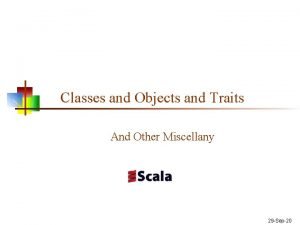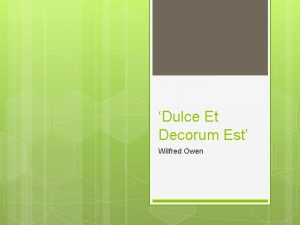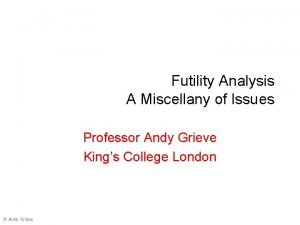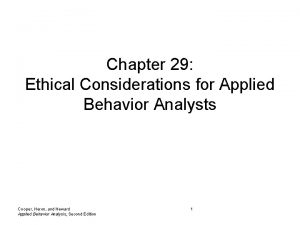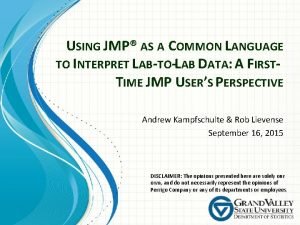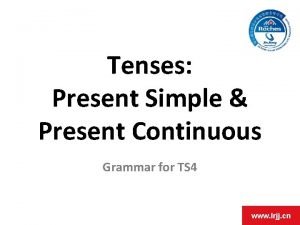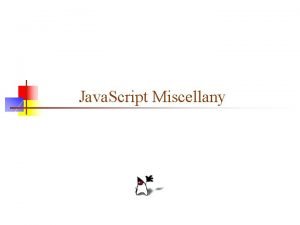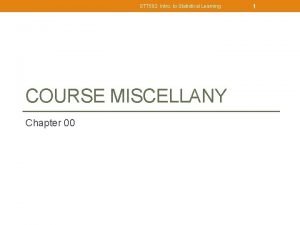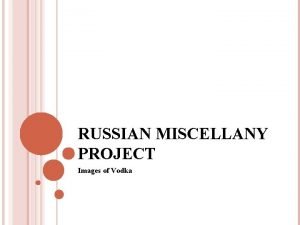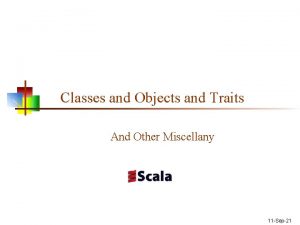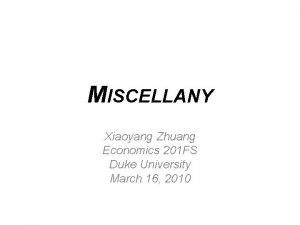Futility Analysis A Miscellany of Issues Professor Andy
















- Slides: 16

Futility Analysis A Miscellany of Issues Professor Andy Grieve King’s College London © Andy Grieve

Early Stopping in Clinical Trials Excess Preferences ■ Following Wald’s work in the 1940’s sequential trials in medicine have been around since the 1950’s (Armitage, 20 Bross) 10 A closed restricted plan 0 0 10 20 30 40 50 (Armitage (Biometrika, 1957) -10 -20 Number of Pairs ■ In 1969 Armitage, Mc. Pherson and Rowe showed the dangers of repeated significance testing – increased type -I error rates ■ Led to the development of group sequential designs by Pocock(1977) , O’Brien/Fleming (1979) ■ Arguably group sequential designs were not taken up © Andy Grieve early by the pharmaceutical industry.

Reasons for Early Stopping ■ Proven efficacy - from a pharmaceutical perspective this may not be a good thing as the sponsor needs to collect enough safety information to convince regulators ■ Proven safety issue(s) – of course for serious adverse events RCTs it may not be necessary to have formal safety stopping rules ■ Lack of Benefit - this could be more problematic if related to purely commercial reasons ■ Curtailment © Andy Grieve

Stopping for Commercial Reasons ■ Lievre et al (BMJ, 2001) Premature discontinuation of clinical trials for reasons not related to efficacy, safety or feasibility ■ Evans and Pocock (BMJ, 2001). Editorial: Societal responsibilities of clinical trial sponsors Lack of commercial pay off is not a legitimate reason for stopping a trial ■ Boyd (BMJ, 2001). Commentary: Early discontinuation violates Helsinki principles. ■ Cannistra (J Clin Oncol, 2004). The ethics of early stopping rules: Who is protecting whom? ■ Psaty and Rennie (JAMA, 2003). Stopping medical research to save money – A broken pact with researchers and patients. ■ Iltis (J Med ethics, 2004). Stopping trials early for commercial reasons: the risk-benefit relationship as a moral compass. ■ Trotta et al (Ann. Oncology, 2008). Stopping a trial early in oncology; for patients or for industry? © Andy Grieve

Curtailment ■ Introduced in Quality Control ■ If greater than 5 defects out of a sample of 20 from a batch reject it. ■ Observe 5 defects at anytime before 20 no need to sample further ■ Alling (JASA, 1963) - considered the same idea in sequential application of a Wilcoxon test, © Andy Grieve

Curtailment in a Clinical Trial ■ Two treatments, 20 patients per group ■ After 10 patients per group following results : ■ Active 4/10 , Control 8/10 : minimum possible control response at completion is 8/20 ■ Only active response rates which are significant given 8/20 in controls are : ■ 15/20 , 16/20 , 17/20 , 18/20 , 19/20 , 20/20 - Impossible !! ■ Of course if the active had been 5/10 then – in theory a significant result could have been possible – but how likely is it to get 10/10 on active and 0/10 on controls. ■ We need to be able to calculate the appropriate probability – but under what assumption? © Andy Grieve

Stochastic Curtailment Conditional and Predictive Power ■Assume m pts are treated in each of 2 groups and that the posterior distribution of , the difference in means, is where ym is the difference in sample means and ■The posterior probability that is positive is (1 -sided p-value) ■By analogy the posterior probability after N=m+n pts in each group is where on a further 2 n pts and yn is the difference in means based

Stochastic Curtailment Conditional and Predictive Power ■If a trial is regarded as a success when PN > 1 - implies ■By definition, - the planned alternative - so that conditional on

Stchastic Curtailment Conditional and Predictive Power ■ Similarly on ym so that conditional ■ This is not just a Bayesian result since by definition

Futility or Lack of (sufficient) Benefit ■ What is futility? ■ In my mind futility is a prospective/predictive concept © Andy Grieve

Change in Neurological Score An Example of the Use of “Predictive Power” Frei et al (Stroke, 1987) 80 18 23 20 60 • • 40 • 20 0 • • • -20 -40 -60 Glycol + Rheo Placebo • © Andy Grieve Comparison of Glycol, Placebo and Glycol + Dextran Endpoint Change from Baseline Matthews Neurological Scale Planned : Sample size 200, interim after 100 patients Recruitment was slow Unplanned interim after 52 patients Predictive Probability of “achieving experimental significance with a total of 200 patients” =0. 06 STOPPED FOR FUTILITY

Effect Over Placebo ASTIN Trial – Acute Stroke FDA Workshop, Washington 2003 Dose Effect Curve Efficacy (>2 pts) 0 Futility (< 1 pt) ED 95* Dose

POC Study in Neuropathic Pain Smith et al (Pharmaceutical Statistics, 2006) © Andy Grieve 13

Aside on Early Stopping for Lack of Benefit ■ I have been involved in 10 adaptive clinical trials – either as designer, or as a member of a DSMB ■ ALL have stopped early for lack of Benefit / Futility ■ I’m not surprised / I’m pleased ■ > 95% of all chemical / biological considered as medicines fail ■ Between 80 and 90% fail in phases I-III ■ I therefore have a high subjective probability on starting a study that the drug doesn’t work © Andy Grieve

Arguments Against Predictive Power ■ Bayesians have criticised p-values as being probabilities of events that “could have happened but didn’t” ■ Predictive power is a probability of events that “might happen but haven’t - yet”. ■ Armitage (Cont Clin Trials, 1991) argues against the use of predictive power as a formal stopping rule – as do Spiegelhalter, Abrams and Myles ● It gives undue weight to “significance” ● Makes strong assumptions about the comparability of future data with the past – for example if future data involve follow-up there may be a reliance on an assumption of proportional hazards © Andy Grieve

Publicly Funded Trials and Futility ■ Should futility/lack of benefit be used in publicly funded trials? ■ In some cases yes. ■ For example, I see no scientific reason why futility / lack of benefit should not be used in experimental medicine studies ■ The non-scientific reason might have to do with the appointment of RAs, post docs etc as part of the grant © Andy Grieve
 Miscellany objects
Miscellany objects Futility by wilfred owen analysis
Futility by wilfred owen analysis Futility wilfred owen analysis line by line shmoop
Futility wilfred owen analysis line by line shmoop Futility analysis meaning
Futility analysis meaning Promotion from associate professor to professor
Promotion from associate professor to professor Exercise in futility meaning
Exercise in futility meaning Andy field factor analysis
Andy field factor analysis Andy shawshank redemption character analysis
Andy shawshank redemption character analysis Spiral jetty analysis
Spiral jetty analysis Ethical issues in applied behavior analysis
Ethical issues in applied behavior analysis What tourist places does tamal tell andy about?
What tourist places does tamal tell andy about? Andy kampfschulte
Andy kampfschulte Andy naranjo
Andy naranjo The coming kingdom andy woods
The coming kingdom andy woods Andy woods daniel
Andy woods daniel Andy woods daniel
Andy woods daniel Verb to be in english
Verb to be in english
